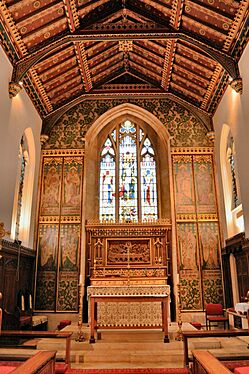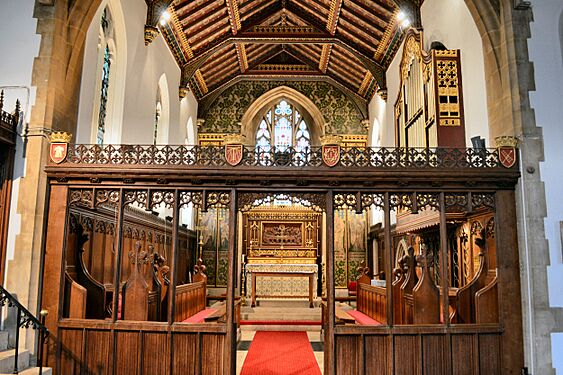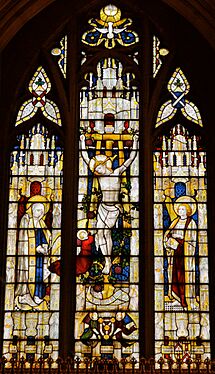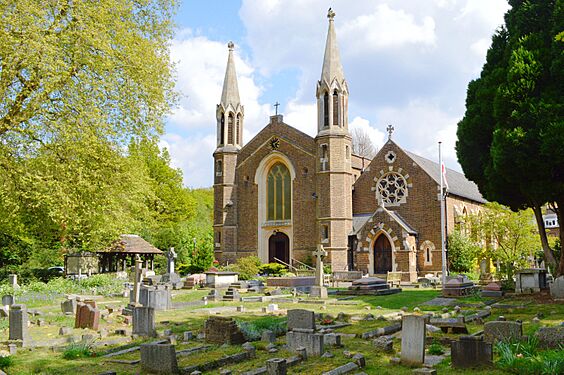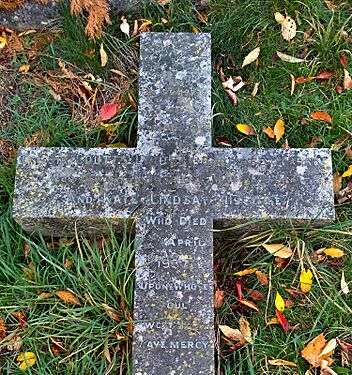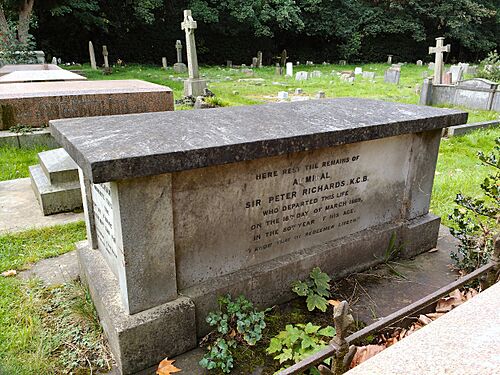St Andrew's Church, Ham facts for kids
Quick facts for kids St Andrew's Church, Ham |
|
|---|---|
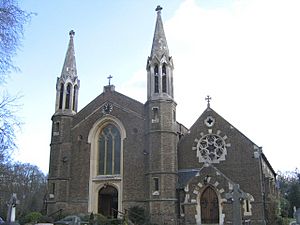 |
|
| 51°25′58.3″N 0°18′11.7″W / 51.432861°N 0.303250°W | |
| Location | Church Road, Ham Common, Richmond TW10 5HG |
| Country | England, United Kingdom |
| Denomination | Church of England |
| Architecture | |
| Architect(s) | Edward Lapidge |
| Years built | 1830–31 |
| Specifications | |
| Materials | Bath stone dressings and London stock brickwork |
| Administration | |
| Parish | Ham, St Andrew |
| Deanery | Kingston |
| Archdeaconry | Wandsworth |
| Episcopal area | Kingston |
| Diocese | Southwark |
| Province | Canterbury |
St Andrew's Church, Ham, is a Grade II listed Church of England church. You can find it on Church Road, Ham Common in Ham. This area is part of the London Borough of Richmond upon Thames.
Contents
Church Design and Art
The church was built in 1830–31 using grey bricks. The architect who designed it was Edward Lapidge. Later, in 1860, a side section called a south aisle was added. This part has a beautiful rose window, which is a round window with patterns like a rose. This addition was designed by Raphael Brandon.
Even later, in 1900–01, a chancel was added. This is the part of the church near the altar. It was built with red bricks by a team called Bodley & Garner. The detailed carvings on the screen and the choir stalls were made by John Harper.
Stained Glass Windows
St Andrew's Church has 32 windows in total. Eleven of these windows have stained glass, which means they are made of colored pieces of glass. These were put in between 1901 and 1948. Four of them were created by a company called Shrigley & Hunt.
One special window is at the west end of the church. It has three parts and was installed in 1932. This window was designed by Hugh Ray Easton. The middle part shows Saint Andrew, who the church is named after. The sides show scenes of baptism and confirmation, which are important church ceremonies.
Another important window is the east window, which shows the Crucifixion. It was designed by Sir Ninian Comper in 1900. This window was put in to remember Harry Scott of Ancrum. Around the main altar, there are also eight large paintings of important religious figures called prophets and evangelists.
There is also a stained glass window that remembers Sir George Dance (1857–1932). He was a writer and manager for plays. The window also remembers his son Erik, who sadly died in a prison camp during World War II.
At the back of the church, you can see special painted wooden panels called funerary hatchments. These are dedicated to Lionel Tollemache, 4th Earl of Dysart and his wife, Countess Grace.
Famous People Buried Here
The cemetery at St Andrew's Church is the final resting place for many interesting people. Here are a few of them:
- Carlos Bovill (1882–1938): He was a balloonist during World War I.
- Violet Hyacinth Bowes-Lyon (1882–1893): She was the older sister of Elizabeth Bowes-Lyon, who later became the Queen Mother. Violet died when she was young.
- Major George Shannon Dockrell (1886–1924): He was an Olympic swimmer who competed for Great Britain in the 1908 Summer Olympics. He also served in the army during World War I and was wounded.
- General William Eden (1768–1851): An army officer who was recognized for his bravery during a battle in Java in 1811.
- Samuel Joseph Gray (1849–1906): He was a soldier in the Rifle Brigade. After leaving the army, he became a Park Keeper and later a Yeomen of the Guard, who are ceremonial guards at the Tower of London.
- Sir Walter Henry Harris (1852–1922): He was a Sheriff of the City of London and was knighted in 1919.
- Wilfred Hudleston Hudleston (1828–1909): An English geologist, which is a scientist who studies rocks and the Earth. His tombstone says he was an "eminent scientist."
- Sir Coutts Lindsay (1824–1913): He was an artist who painted with watercolors.
- John Minter Morgan (1782–1854): An author who cared about helping others. He started a home for orphans on Ham Common in 1849.
- Sir Richard Owen (1804–1892): A very important biologist and paleontologist. He studied living things and ancient fossils.
- Charles Gottlieb Pfander (1803–1865): He was a missionary who worked to spread Christianity.
- Admiral Sir Peter Richards (1787–1869): A high-ranking officer in the Royal Navy.
- Sarah Smith (1832–1911): She was a writer who wrote children's books under the name Hesba Stretton.
- Hugh Colin Smith (1836–1910): He was the Governor of the Bank of England from 1897 to 1899.
The cemetery also holds the graves of three people who died during wars:
- Irene Daisy Collett of the Women's Auxiliary Air Force (died 1943).
- Ronald Oswald Dibben of the Royal Air Force Volunteer Reserve (died 1942).
- William Samuel Hudson Palmer of the Royal Flying Corps (died 1917).
There is also the grave of Dr. Frederick Carson, who was a captain in the R.A.M.C. in World War I. He received a special award called the Military Cross in 1918.
Members of the Shafto family are also buried in the cemetery.
Church Activities
St Andrew's Church is a busy place!
- They have a church service every Sunday morning.
- There's a Sunday School for children aged 3 to 11 years old.
- Older children can join a youth group.
Since 1980, German-speaking Lutheran services have also been held at St Andrew's. These services are in the German language and happen twice a month on Sunday afternoons. There's also a Sunday school for children during these services.
The church also holds special ecumenical services. These are shared services between the Anglican St Andrew's church and the German-speaking Catholic church. The Catholic church holds its services at St Thomas Aquinas, Ham.
Gallery
Church interior
Church exterior
Churchyard tombs
-
Grave of Sir Coutts Lindsay
-
Grave of Sarah Smith (Hesba Stretton)


